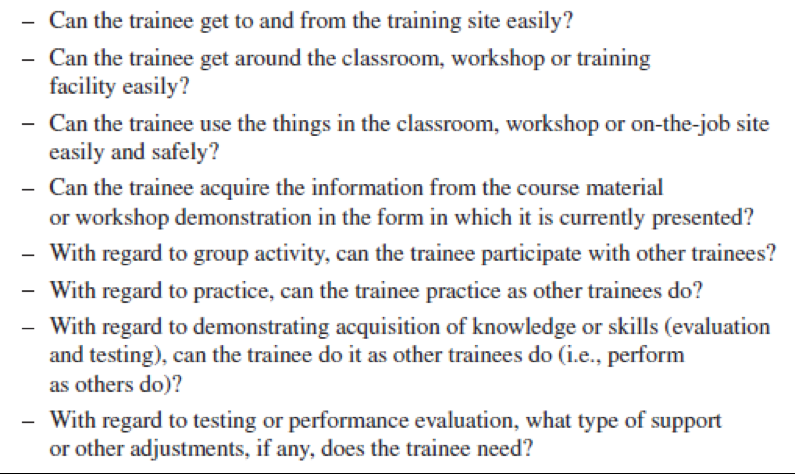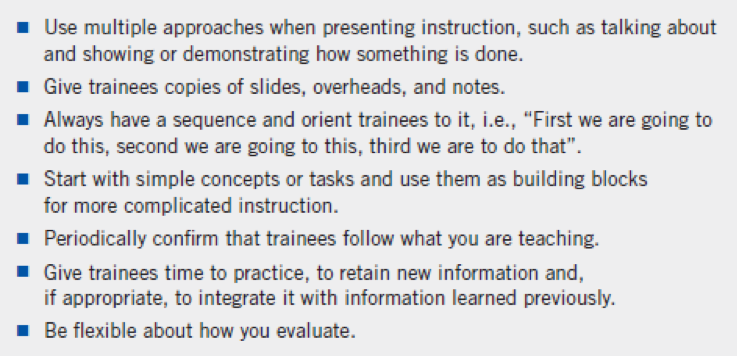
1 - How pupils create an e-portfolio for employment
The curriculum vitae is one of the most fundamental pieces for a successful entry into the job market. In this sense, a CV model was created that encompassed both the pedagogical and the professional part, i.e., it was an intuitive model composed of a simple and appealing layout, complying with the standards defined on the construction of “a good CV”. Knowing that the target audience of this course is students with Intellectual and Developmental Disabilities (DID), one of the main challenges in the development of this CV model would be the simplification, both of the structure itself and the elements to be filled by the students. As such, the following sections have been designated:
2 - How to prepare pupils to an interview
Read more about: Interviewing candidates with different types of disabilities
3 - Good Practices of Inclusion for People with Disabilities in Training
Persons with disabilities make up 15% of the world’s population (International Labour Organization, 2018). Disability includes a range of impairments – including physical, sensory, intellectual or psychosocial – which, in interaction with attitudinal and environmental barriers limits full participation in society (International Labour Organization, 2018).
The United Nations Convention on the Rights of Persons with Disabilities of 2006 provided a new momentum for the promotion of the right of persons with disabilities to work. Inclusion of people with disabilities in the workplace, including people with Down syndrome or intellectual disabilities, is a human right enshrined in 2008 by Article 27 of the UN Convention on the Rights of Persons with Disabilities:
“States Parties recognize the right of persons with disabilities to work, on an equal basis with others; this includes the right to the opportunity to gain a living by work freely chosen or accepted in a labour market and work environment that is open, inclusive and accessible to persons with disabilities.” (United Nations, 2006, pp. Article 27, n. 21).
Furthermore, the Sustainable Development Agenda 2030 commits the international community to achieve decent work for all persons with disabilities (International Labour Organization, 2018).
Through the text we use the terms “disabled person” and “person with a disability” interchangeably, following the practice of International Labour Office (International Labour Organization, 2013). Following the ILO definition, a disabled person is:
“An individual whose prospects of securing, returning to, retaining and advancing in suitable employment are substantially reduced as a result of a duly recognized physical, sensory, intellectual or mental impairment.” (International Labour Organization, 2013, p. 2)
3.1 Basic concepts related to inclusion
The first good practice of inclusion of people with disabilities is both administrators and trainers to understand the basic concepts related with it. “Inclusion does not just happen in the classroom, it happens throughout the facility and hopefully the entire training system and even the community.” (International Labour Organization, 2013, p. 14).
Achieving the inclusion is a process. “Some basic methods of achieving inclusion relate to making the environment and services accessible by using universal design when building or planning” (International Labour Organization, 2013, p. 9). According to the UNCRPD, universal design means “the design of products, environments, programmes and services to be usable by all people, to the greatest extent possible, without the need for adaptation or specialized design.” (International Labour Organization, 2013, p. 9).
“The concept of universal design is being applied more broadly than just to the physical environment, where it originated. It is used in computer hardware, software, and information sharing, and also in human services of all kinds, in classrooms, courts, police departments, retail stores, and many businesses. Universal design can also be applied and practiced in recruiting trainees, in testing applicants, in offering instruction, including in the presentation of print and electronic materials, and designing internships and curriculum. The concept of universal curriculum design means, among other things, using a variety of training techniques so that everyone can learn according to differing and preferred learning styles.” (International Labour Organization, 2013, p. 10).
Awareness training and the accessibility of the facility are two areas that administrators should considerer. The administrators need to identify who needs disability awareness training (the trainers, the staff), who will do the trainer and the cost. “Negative attitudes are usually the most significant barrier that people with disabilities face and it often underlies the failure to address other barriers such as those related to accessibility, laws and policies and others. Disability awareness training or disability equity training is an approach to dispelling such negative attitudes.” (International Labour Organization, 2013, p. 13)
By the other hand, people with disabilities need reasonable accommodation and a good access to the facilities. “In training situations, reasonable accommodations are actions taken or tools and devices provided to address the specific needs of the trainee. If the training venue has already been made accessible, few additional changes will be needed. However, whether the barriers presented relate to general accessibility or the need for an individual reasonable accommodation” (International Labour Organization, 2013, p. 11), in Figure 1 there are key questions to keep in mind when deciding on additional adjustments.
Source: ILO (2013, p. 12)

In a school or a work, planning for inclusion increases the likelihood of success. “Planning is often considered an administrative task but for planning to be effective it must include instructors, facility staff, especially those responsible for building renovations and safety and, perhaps, community organizations, employers’, workers’ organizations and disabled people’s organizations, parents and other community leaders.“ (International Labour Organization, 2013, p. 28).
Inclusive vocational training systems have the following characteristics (International Labour Organization, 2013, p. 19):
3.2 Good practices of inclusion for people with disabilities in training
In training people with disabilities “what” you teach will not change (relatively to what is taught to trainees without disabilities), but “how” you teach might change (International Labour Organization, 2013). In this section we present some of the techniques and strategies to change how you teach, following the approach of ILO (see Figure 2).
Source: Adapted from ILO (2013)
Figure 2 – Strategies for facilitating the acquisition of knowledge
In training of people with disabilities the tutors should follow the techniques of universal design. The Figure 3 presents suggestions for applying the universal design techniques to instruction or training.
Source: ILO (2013, p. 11)

3.3 Giving feedback
“All trainees benefit from feedback, delivered in the right way and the right time. Feedback should always be specific. “Good job!” is insufficient. Its impact is likely to be greater if phrased like this: “Good job! You followed the steps correctly to compress the computer files.” Being specific is critically important when giving a trainee feedback on poor performance, also.
It’s easy and pleasant to give public positive feedback for a job well done to any or all trainees. It is more of a challenge when you must note poor performance.” (International Labour Organization, 2013, p. 39).
“You need to be a fair judge and be perceived as a fair judge. So, tie feedback to performance not the person. For example, do not say, “Juan you are wrong, again!” Say instead, “Juan, the next time you shut down the computer, please close all running programmes first. That way you will not lose any files.” If you have negative feedback to give, if you can, do it in private. If you cannot, find something in the performance to characterize favorably, even if the news is mostly bad. Be consistent over time.” (International Labour Organization, 2013, pp. 39-40).
Read more: ILO-Practical-Guide-disabilities-VT
Online resources:
International Labour Organization. (2013). Inclusion of People with Disabilities in Vocational Training: A Practical Guide. Retrieved from International Labour Office, Gender, Equality and Diversity, Geneva: https://www.ilo.org/wcmsp5/groups/public/—dgreports/—gender/documents/publication/wcms_230732.pdf
References:
ILO. (2013). Inclusion of People with Disabilities in Vocational Training: A Practical Guide. Retrieved from International Labour Office, Gender, Equality and Diversity, Geneva: https://www.ilo.org/wcmsp5/groups/public/—dgreports/—gender/documents/publication/wcms_230732.pdf
© 2021, StartingUp4Inclusion. All Rights Reserved.
